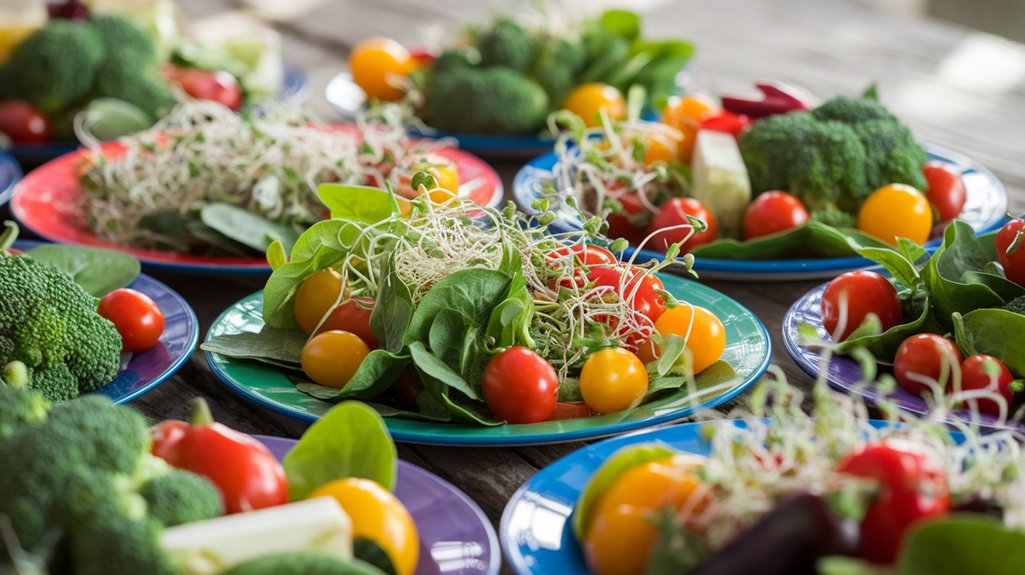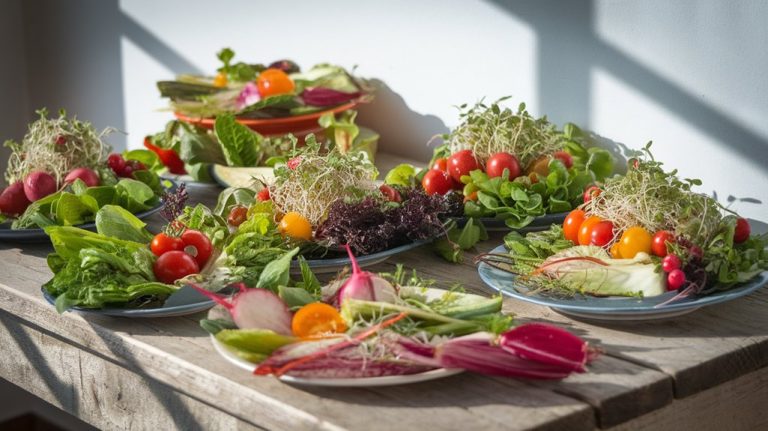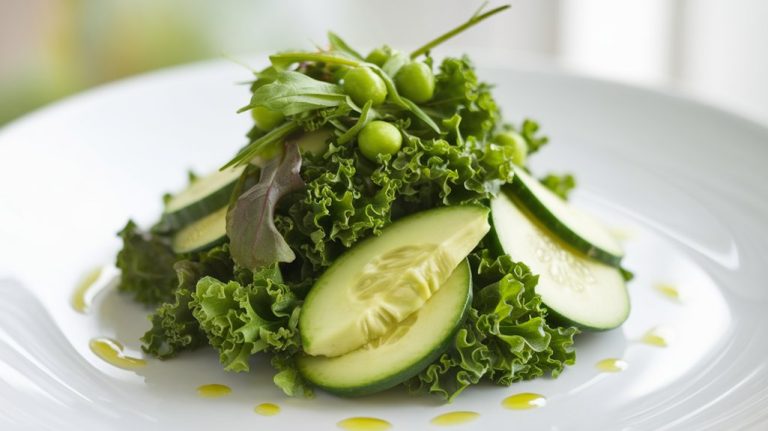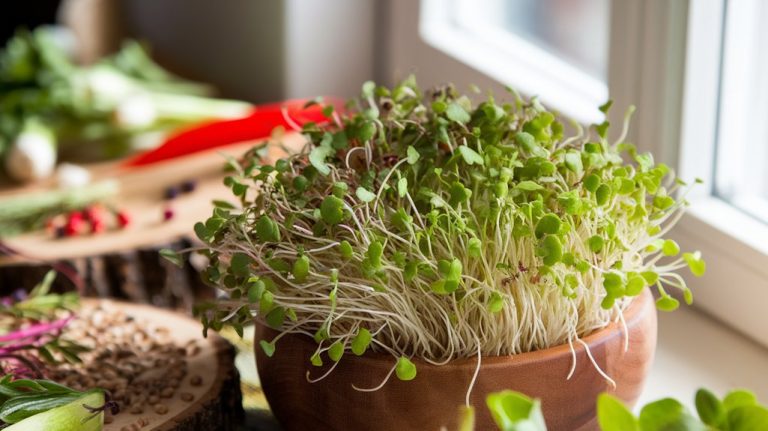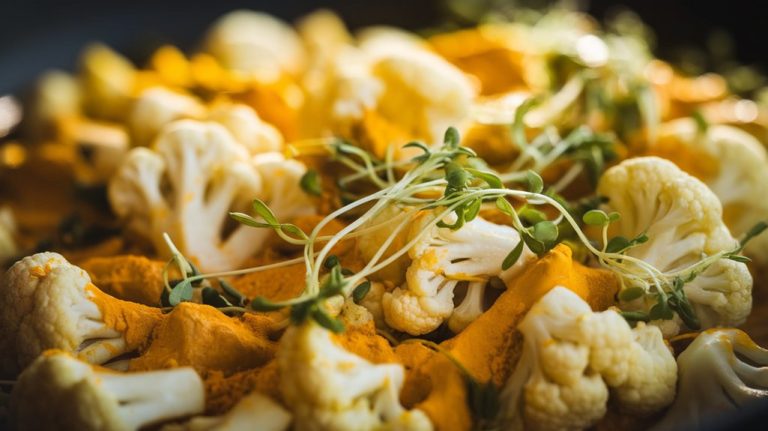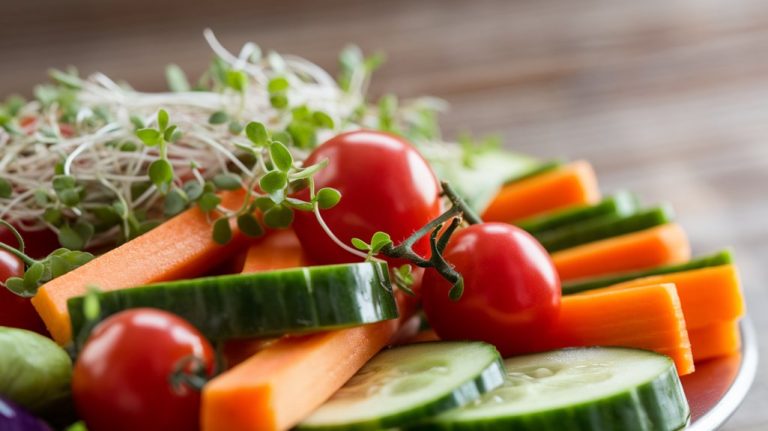Vibrant Plates Full of Vegetables and Fresh Sprouts
Vibrant plates full of colorful vegetables and fresh sprouts not only catch my eye but also nourish my body. The reds of tomatoes and bell peppers, deep greens of spinach and kale, along with the warm oranges of carrots provide a spectrum of essential nutrients. Fresh sprouts, like alfalfa and broccoli, add unique flavors and boost nutritional content. These colorful dishes inspire creativity in my cooking, and there’s so much more to explore about these delicious, healthy options!
Key Takeaways
- Incorporate a variety of colorful vegetables like reds, greens, and oranges to enhance both nutritional value and visual appeal on your plate.
- Use fresh sprouts such as alfalfa, broccoli, and sunflower to add crunch and boost nutrient density in salads and sandwiches.
- Experiment with creative meal preparations like zucchini noodles and stuffed bell peppers to make vegetable dishes more exciting and satisfying.
- Select vibrant, firm vegetables and store them properly to maintain freshness and flavor for optimal enjoyment.
- Embrace seasonal eating to enjoy peak flavors and support local agriculture while reducing your environmental impact.
The Nutritional Benefits of Colorful Vegetables
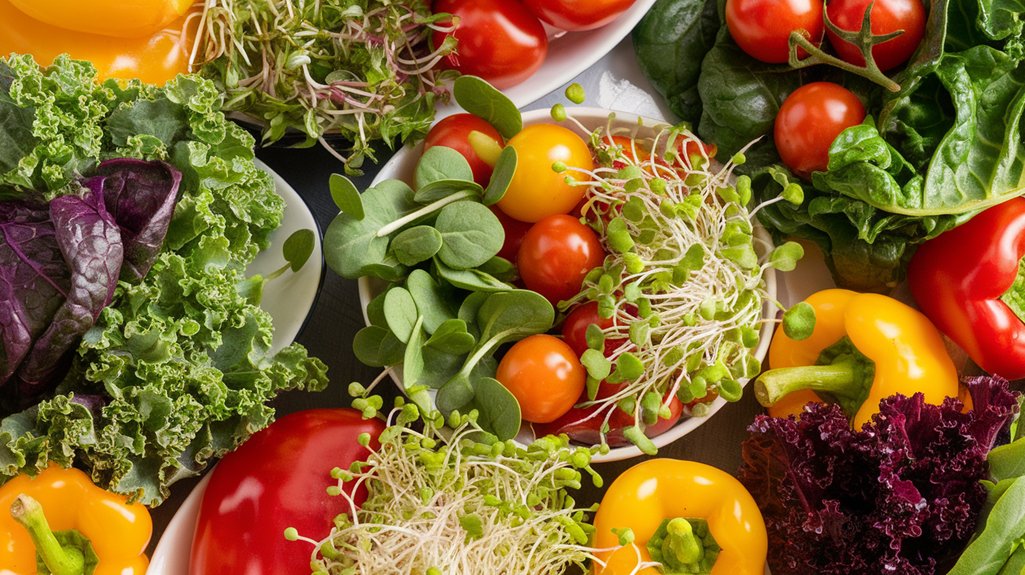
When I think about colorful vegetables, I can’t help but marvel at the nutritional treasures they hold. Each hue brings its own set of vitamins and minerals, making them essential for our health.
For instance, vibrant reds, like tomatoes and bell peppers, are packed with antioxidants that support heart health. Deep greens, such as kale and spinach, are rich in iron and calcium, vital for strong bones. Bright oranges, like carrots and sweet potatoes, deliver a hefty dose of beta-carotene, promoting eye health.
The diversity of colors not only makes our plates visually appealing but also ensures we receive a wide range of nutrients. So, the next time you fill your plate, remember: those colorful veggies are doing wonders for your body!
Exploring Different Types of Fresh Sprouts
When I think about fresh sprouts, I can’t help but marvel at their vibrant flavors and impressive nutritional benefits.
From crunchy alfalfa to zesty radish sprouts, each variety brings something unique to the table, and growing them at home is surprisingly simple.
Join me as we explore the world of sprouts and discover how they can elevate our meals!
Nutritional Benefits of Sprouts
Have you ever wondered why sprouts have gained such popularity in healthy eating circles? It’s no surprise, really.
Sprouts are nutritional powerhouses packed with vitamins, minerals, and enzymes that promote digestion. Just a handful of alfalfa or broccoli sprouts can provide a significant boost of vitamin C, while lentil sprouts are rich in protein and fiber. Their unique sprouting process enhances nutrient absorption, making them even more beneficial.
Plus, they’re low in calories, so you can enjoy them guilt-free! I love tossing a mix of sprouts into salads or sandwiches for that crunch and freshness.
With their vibrant colors and delightful textures, sprouts not only nourish the body but also elevate any dish on your plate.
Popular Sprout Varieties
Sprouts come in a variety of flavors, textures, and colors, making them a versatile addition to any meal.
I love incorporating alfalfa sprouts into my salads for their delicate crunch and mild taste. Meanwhile, broccoli sprouts pack a punch with their peppery flavor and impressive nutritional profile.
If you’re looking for something with a nutty twist, try sunflower sprouts—they’re not only delicious but also add a vibrant green hue to your dishes. For a more exotic option, consider radish sprouts, which bring a spicy kick that livens up sandwiches and wraps.
Each variety offers unique benefits and can enhance both the taste and appearance of your meals, encouraging creativity in the kitchen.
Growing Sprouts at Home
Although growing sprouts at home may seem daunting, it’s surprisingly simple and rewarding. I love watching those tiny seeds transform into vibrant, crunchy sprouts right on my kitchen counter.
Here are three types I recommend trying:
- Alfalfa: These delicate sprouts add a mild, nutty flavor to salads and sandwiches.
- Mung Bean: With their crisp texture, they’re perfect for stir-fries and Asian dishes.
- Broccoli: Packed with nutrients, these sprouts have a peppery taste that livens up any meal.
All you need is a jar, some seeds, and water. Just rinse and drain daily, and in about a week, you’ll have fresh, homegrown sprouts ready to elevate your dishes.
It’s a delightful process!
Tips for Selecting and Storing Vegetables and Sprouts
When it comes to selecting and storing vegetables and sprouts, I always look for vibrant colors and firm textures that signal freshness. I find that the crunchier the vegetable, the better it tastes. When I get home, I store them properly to maintain that crispness. For leafy greens, I keep them in a breathable bag in the fridge. Root vegetables love cool, dark places.
Here’s a quick reference:
| Vegetable/Sprout | Selection Tips | Storage Tips |
|---|---|---|
| Spinach | Bright green leaves | Refrigerate in a bag |
| Carrots | Firm and crunchy | Store in a cool place |
| Broccoli | Deep green florets | Keep in the fridge |
| Alfalfa Sprouts | Fresh and moist | Refrigerate in a container |
Creative Ways to Incorporate Vegetables Into Your Meals
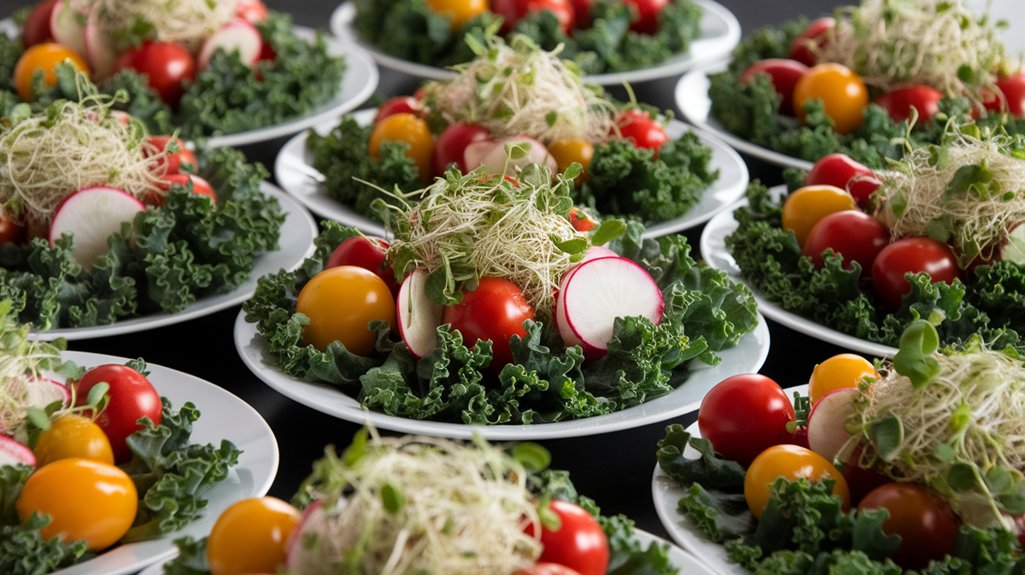
Incorporating vegetables into my meals isn’t just about nutrition; it’s about elevating flavors and creating vibrant dishes that excite the palate.
I love experimenting with different ways to include veggies, and here are three creative ideas that really stand out:
- Zucchini Noodles: Spiralizing zucchini creates a delightful pasta alternative, soaking up sauce flavors beautifully.
- Stuffed Bell Peppers: Hollow out colorful bell peppers and fill them with quinoa, black beans, and spices for a satisfying meal.
- Vegetable Smoothies: Blend leafy greens like spinach or kale with fruits for a refreshing and nutritious drink that masks the earthy flavors.
These methods not only enhance my meals but also make them visually appealing, adding a burst of color to my plate!
The Art of Plating: Making Your Dishes Visually Appealing
When I plate my dishes, I love playing with color contrast to make each element pop.
Layering different textures and heights not only adds depth but also invites curiosity about the flavors.
Let’s explore how these techniques can transform a simple vegetable dish into a stunning centerpiece.
Color Contrast Techniques
Color contrast techniques can transform a simple plate of vegetables into a striking work of art. When I plate my dishes, I focus on bold colors to create visual impact.
Here are three techniques I love to use:
- Vibrant Greens: Fresh spinach or kale stands out beautifully against a creamy white plate, making the greens pop.
- Bright Reds and Oranges: Roasted bell peppers or carrots add warmth and contrast, drawing the eye immediately.
- Deep Purples: Eggplant or purple cabbage introduces depth and a touch of sophistication, balancing the overall palette.
Layering for Depth
Layering brings a dynamic quality to vegetable plating that elevates the overall presentation.
When I plate, I start with a base of greens—perhaps a bed of arugula or kale. Next, I add colorful vegetables like roasted beets or vibrant bell peppers, stacking them artistically. This not only creates height but also invites the eye to explore the dish.
I often sprinkle fresh herbs or microgreens on top, adding texture and freshness. A drizzle of balsamic reduction or a splash of citrus dressing can tie it all together, enhancing flavor and visual appeal.
Flavor Pairings: Enhancing the Taste of Vegetables and Sprouts

Although vegetables and sprouts often take a backseat in many dishes, I find that the right flavor pairings can elevate them to star status on any plate.
Here are three combinations that never fail to impress:
- Roasted Brussels Sprouts with Balsamic Glaze: The tangy sweetness of balsamic drizzle perfectly complements the earthy notes of Brussels sprouts, creating a delightful contrast.
- Carrots with Ginger and Honey: The warmth of ginger and the sweetness of honey bring out the natural sugars in carrots, making each bite a sweet surprise.
- Radishes with Sea Salt and Lemon: A sprinkle of sea salt and a squeeze of fresh lemon brightens the peppery flavor of radishes, adding a refreshing zing.
These pairings transform humble vegetables into something truly special!
Seasonal Vegetables: Eating With the Seasons
When I think about the joy of cooking, using seasonal vegetables truly stands out as one of my favorite practices. There’s something magical about picking fresh produce at its peak, bursting with flavor and nutrients.
I love wandering through local farmers’ markets, where vibrant colors and enticing aromas draw me in. Each season offers a unique bounty—crisp greens in spring, juicy tomatoes in summer, hearty squash in autumn, and earthy root vegetables in winter.
Eating with the seasons not only supports local agriculture but also connects me to nature’s rhythms. I find that seasonal vegetables inspire creativity in my dishes, making every meal a celebration of what’s fresh and delicious right now.
It’s a delightful way to nourish my body and soul.
Quick and Easy Recipes for Vibrant Vegetable Dishes
As I dive into the world of quick and easy vegetable recipes, I find that vibrant flavors and fresh ingredients can transform even the simplest dishes into culinary delights.
Here are three of my go-to recipes that burst with color and taste:
- Zesty Roasted Veggies: Toss diced bell peppers, zucchini, and cherry tomatoes in olive oil, garlic, and herbs, then roast until caramelized and tender.
- Rainbow Salad: Combine shredded carrots, purple cabbage, and crisp cucumber, drizzled with a tangy lemon vinaigrette for a refreshing crunch.
- Sautéed Greens: Quickly sauté spinach and kale with a splash of soy sauce, garlic, and sesame seeds for a savory side that complements any meal.
These simple dishes not only nourish but also brighten up my plate with every bite.
The Environmental Impact of Plant-Based Eating
Exploring vibrant vegetable dishes hasn’t only enriched my meals but also opened my eyes to the broader implications of what we choose to eat.
The environmental impact of plant-based eating is profound. By opting for vegetables and legumes over meat, I’ve significantly reduced my carbon footprint. It’s astonishing to think that livestock farming contributes to deforestation and greenhouse gas emissions.
Each colorful plate I prepare represents a conscious choice to support sustainable agriculture and preserve our planet’s resources. I’ve noticed that seasonal, local produce not only tastes better but also minimizes transportation emissions.
Embracing plant-based meals feels like a delicious way to nurture both my body and the Earth, creating a ripple effect of positive change in our interconnected world.
Frequently Asked Questions
How Can I Grow My Own Fresh Sprouts at Home?
Growing fresh sprouts at home is easier than you’d think!
I start by soaking seeds, like alfalfa or broccoli, in water overnight. The next day, I rinse them and place them in a sprouting jar or tray.
I keep them in a dark, warm place, rinsing them twice daily. In just a few days, I’ve got crunchy, nutritious sprouts ready to enjoy.
It’s rewarding to see my little garden grow right in my kitchen!
What Are Some Common Allergies Associated With Sprouts?
When it comes to sprouts, I’ve learned that some common allergies can arise, particularly with those who’ve sensitivities to legumes or seeds.
For instance, alfalfa and mung bean sprouts can trigger allergic reactions in some people.
I’ve also noticed that individuals with soy allergies might react to soybean sprouts.
If you’re thinking about incorporating sprouts into your diet, it’s wise to be aware of these potential allergies and consult a healthcare professional if you have concerns.
Can I Freeze Fresh Vegetables and Sprouts for Later Use?
Absolutely, I freeze fresh vegetables and sprouts all the time! It’s a great way to preserve their freshness.
I usually blanch them first to maintain their color and nutrients. After cooling, I pack them in airtight bags, squeezing out the air before sealing.
When I’m ready to use them, I just pull a bag from the freezer, and they’re perfect for soups or stir-fries.
It’s a simple trick that saves time and reduces waste!
Are There Any Cooking Methods That Reduce Nutrient Loss in Vegetables?
When it comes to cooking vegetables, I’ve found steaming to be one of the best methods for retaining nutrients. It gently cooks them without submerging them in water, which often leaches vitamins away.
I also love sautéing with a splash of healthy oil; it adds flavor while preserving nutrients. Quick methods like microwaving can also be effective.
I always aim to keep my veggies vibrant and packed with goodness, ensuring I get the most from my meals.
How Do I Know if My Vegetables and Sprouts Are Organic?
When I want to know if my vegetables and sprouts are organic, I always check for labels. Certified organic produce usually has a USDA seal.
I also look for local farmers’ markets, where I can ask growers directly about their practices.
Sometimes, I opt for online stores that specialize in organic products. Trusting my sources helps me feel good about what I’m eating and supports sustainable farming practices.
Conclusion
Embracing vibrant plates filled with colorful vegetables and fresh sprouts not only enhances our meals but also nurtures our bodies and the planet. As I’ve discovered, the nutritional benefits and creative possibilities are endless. By selecting seasonal produce and experimenting with flavors, we can transform everyday dishes into visual masterpieces. So, let’s celebrate the beauty of plant-based eating, savoring every bite while contributing to a healthier lifestyle and a sustainable world. Dive in and enjoy the journey!

